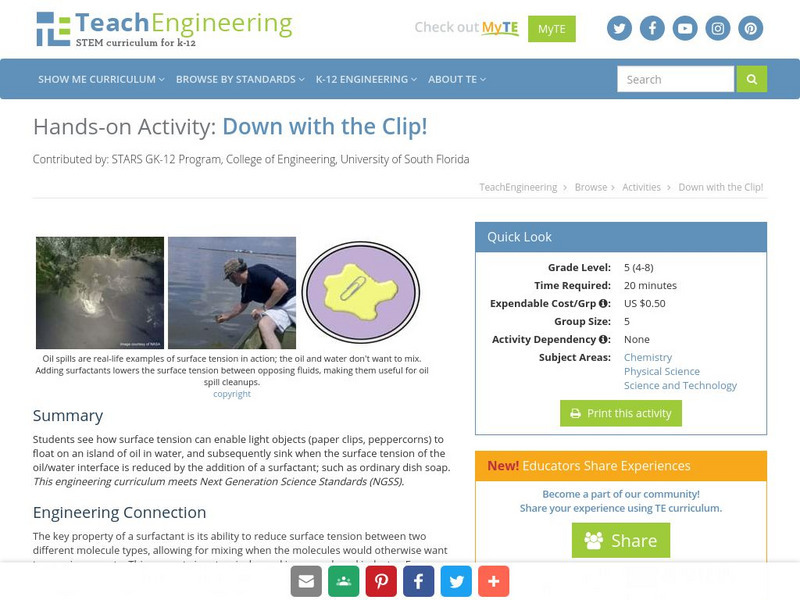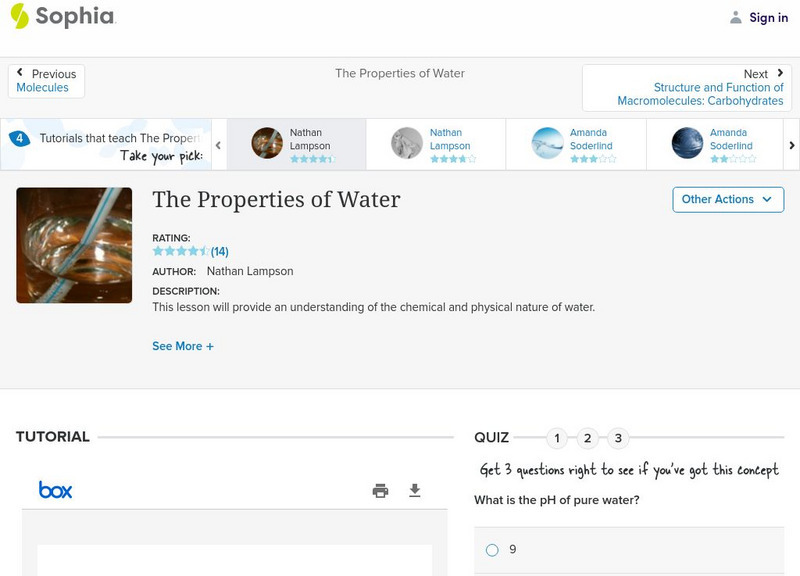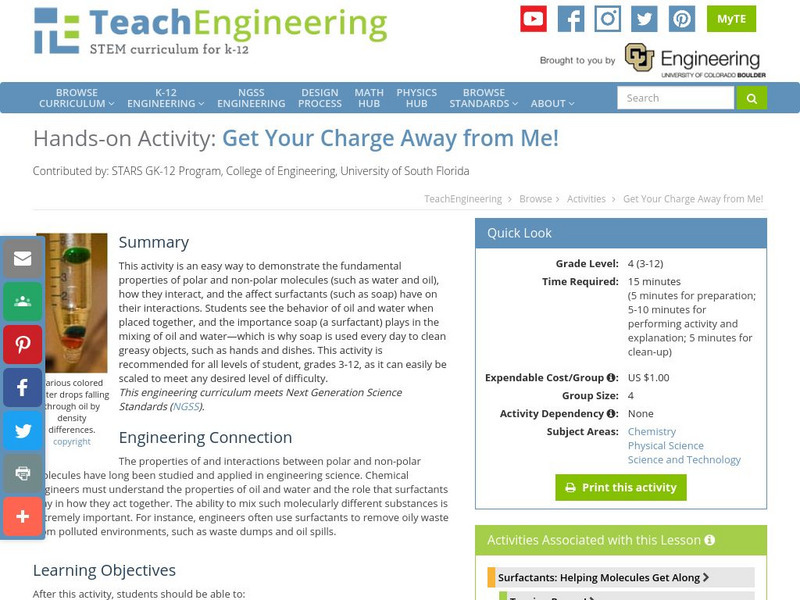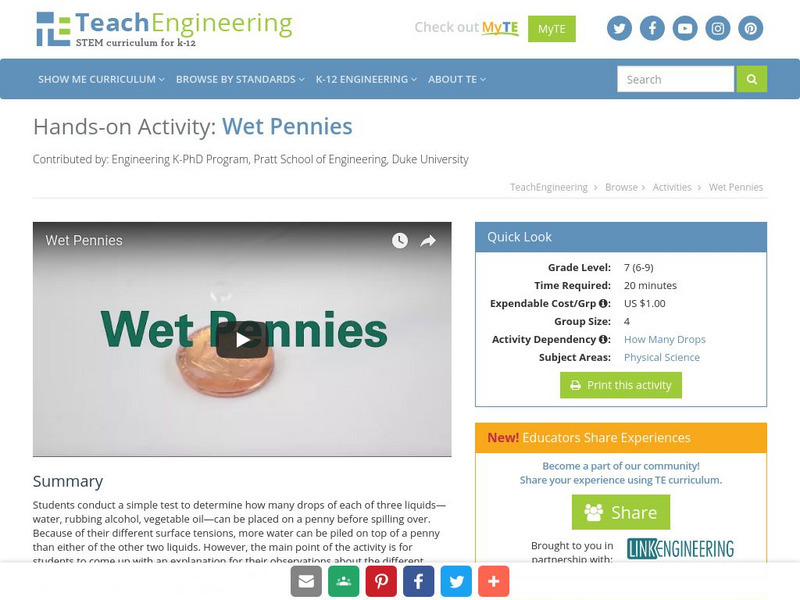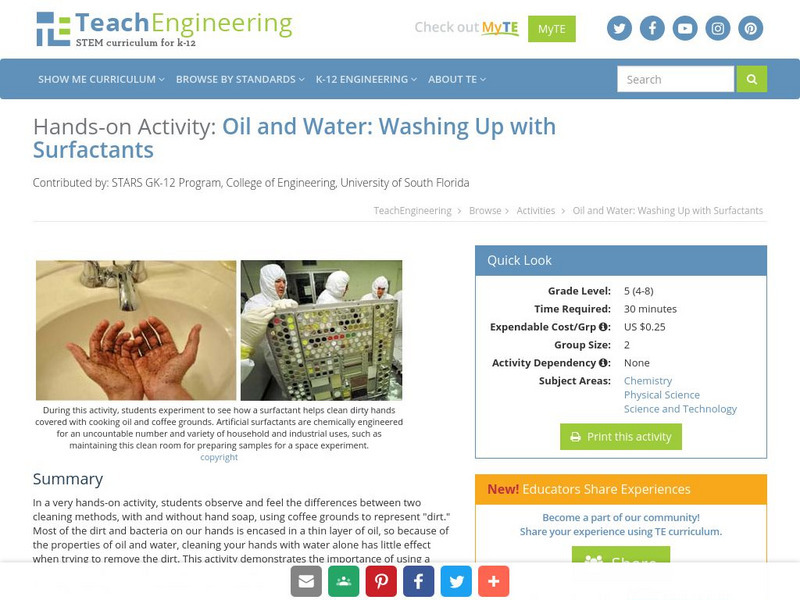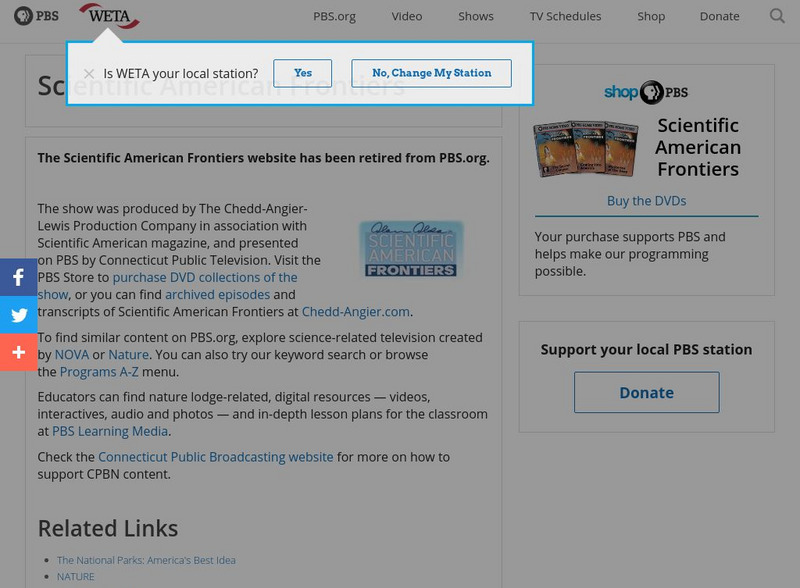CK-12 Foundation
Ck 12: Properties of Water
[Free Registration/Login may be required to access all resource tools.] Students look at the chemical structure of water and learn how it determines water's properties.
TeachEngineering
Teach Engineering: Down With the Clip!
Students see how surface tension can enable light objects (paper clips, peppercorns) to float on an island of oil in water, and subsequently sink when the surface tension of the oil/water interface is reduced by the addition of a...
Middle School Science
Middle School Science: "Sinkin' Lincoln" Lab (Lesson Plan)
In this lesson plan site, students will "Define surface tension, determine what factors affect surface tension, and collect data on how many drops of water a penny can hold."
Education.com
Education.com: Alicia Danyali: Break the Tension: A Water Experiment
[Free Registration/Login Required] Investigate one of water's most important traits, surface tension with this simple experiment that only requires 6 basic household items.
TOPS Learning Systems
Tops Learning Systems: Top Science: Water Domes [Pdf]
Investigate the cohesive tension on the surface of water.
Science Education Resource Center at Carleton College
Serc: Walking on Water How Do Water Striders Do It?
This activity is designed for students to get a first look at water tension. It also allows them to make a model and test a situation seen in nature with materials that are readily available.
Science Bob Pflugfelder
Science Bob: Make a Paperclip Float!
Presents a procedure for getting a paper clip to float in water. Following the procedure, the site gives a brief explanation and discussion of surface tension.
Sophia Learning
Sophia: The Properties of Water: Lesson 4
This lesson will provide an understanding of the chemical and physical nature of water. It is 4 of 4 in the series titled "The Properties of Water."
Sophia Learning
Sophia: The Properties of Water: Lesson 1
This lesson will provide an understanding of the chemical and physical nature of water. It is 1 of 4 in the series titled "The Properties of Water."
TeachEngineering
Teach Engineering: Investigating Contact Angle
Students observe how water acts differently when placed on hydrophilic and hydrophobic surfaces. They determine which coatings are best to cause surfaces to shed water quickly or reduce the "fogging" caused by condensation.
TeachEngineering
Teach Engineering: Exploring the Lotus Effect
Students test and observe the "self-cleaning" lotus effect using a lotus leaf and cloth treated with a synthetic lotus-like superhydrophobic coating. They also observe the Wenzel and Cassie Baxter wetting states by creating and...
TeachEngineering
Teach Engineering: Exploring Capillary Action
Students observe multiple examples of capillary action. First they observe the shape of a glass-water meniscus and explain its shape in terms of the adhesive attraction of the water to the glass. Then they study capillary tubes and...
TeachEngineering
Teach Engineering: Get Your Charge Away From Me!
This activity is an easy way to demonstrate the fundamental properties of polar and non-polar molecules (such as water and oil), how they interact, and the affect surfactants (such as soap) have on their interactions. Students see the...
US Geological Survey
Usgs: Capillary Action
Capillary is described and explained. It is related to surface tension. Examples in botany and human physiology are given.
TeachEngineering
Teach Engineering: Engineering for the Earth
Young students are introduced to the complex systems of the Earth through numerous lessons on its natural resources, processes, weather, climate and landforms. Key earth science topics include rocks, soils and minerals, water and natural...
TeachEngineering
Teach Engineering: Wet Pennies
Students conduct a simple test to determine how many drops of each of three liquids can be placed on a penny before spilling over. The three liquids are water, rubbing alcohol, and vegetable oil; because of their different surface...
Bill Nye
Bill Nye: Float Your Metal Boat
This experiment from Bill Nye shows that breaking the surface tension of a body of water can provide enough energy to propel a boat (or an insect!).
PBS
Pbs Teachers: Soap Powered Boat Experiment
Examine surface tension by floating an index card that has been cut into a boat shape on water, then dropping liquid soap near the "engine" section of the index card.
TeachEngineering
Teach Engineering: Let's Get Dirty
In a very hands-on activity, students observe and feel the differences between two cleaning methods, with and without hand soap, using coffee grounds to represent "dirt."Most of the dirt and bacteria on our hands is encased in a thin...
PBS
Pbs Teachers: Salt and Pepper Experiment
Demonstrate surface tension by sprinkling pepper on a bowl full of water, then touching a soapy finger to the water.
PBS
Pbs Teachers: Scientific American: Science Safari: Fighting Malaria
Explore the issues surrounding the mosquito infestations. Investigate surface tension to explain how the egg rafts stay afloat and mosquitoes are able to stand on the water's surface, and review proper disposal of automobile tires.
Science Bob Pflugfelder
Science Bob: Make a Paper Clip Float [Pdf]
Science activity demonstrates how surface tension is used to suspend a paperclip on the surface of water.
PBS
Pbs Teachers: Flying High: Taking to the Air
Explore the science of surface tension, the evolution of flight in insects and insects' anatomical adaptations. Construct insect models that illustrate the action of these adaptations and calculate the force per unit area of water surface.
PBS
Pbs Teachers: Floating Paper Clips Experiment
Explore surface tension in water by making a paper clip float.

